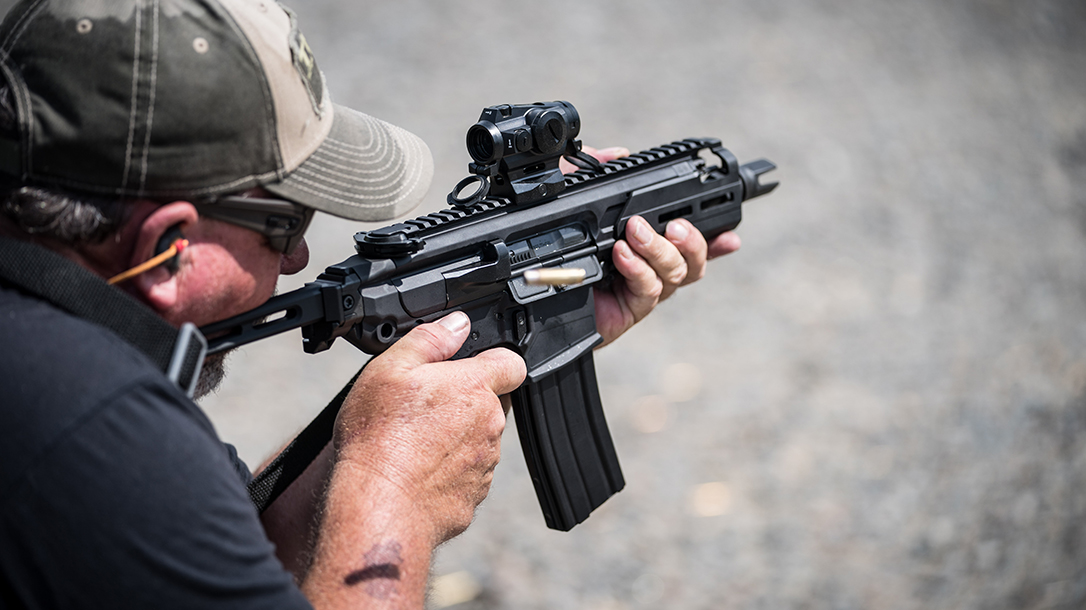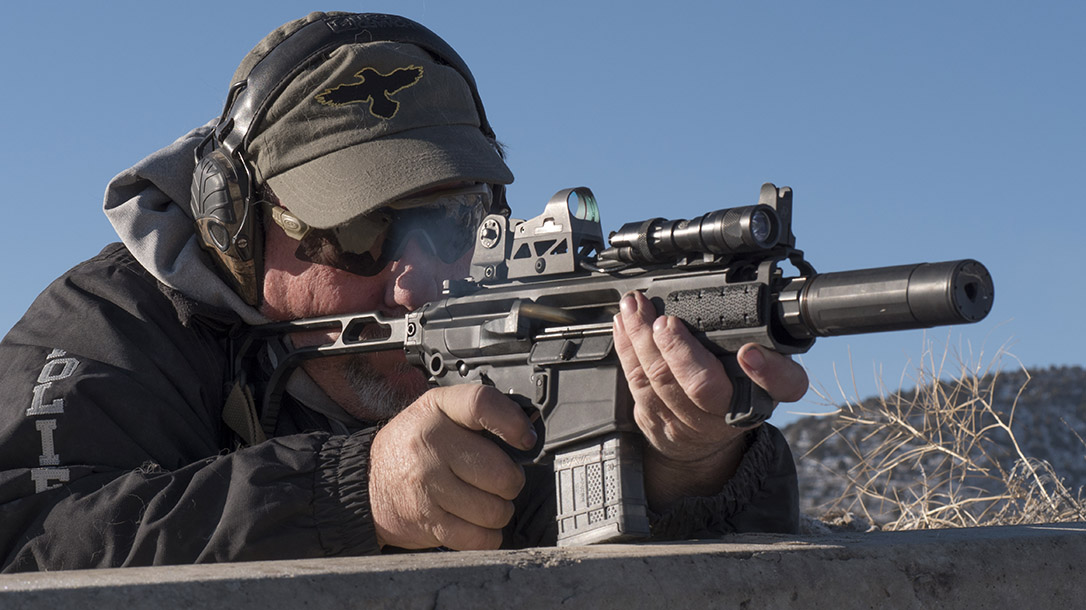The SIG Rattler is something special. Before we get there, let’s look at the concept of the personal-defense weapon (PDW). It began in earnest in the late 1980s. The idea was to replace 9mm submachine guns for support troops and special operations units with something more powerful that wasn’t a full-sized rifle. This lead to some interesting designs that used proprietary cartridges, like the 5.7x28mm FN P90 and 4.6x30mm HK MP7.
SIG MCX Rattler Origins
These guns eventually faded away—partially because of their ammunition and because it was easier to use a variant of the M4 Carbine—but the need did not. Units specializing in covert, ship-borne or hostage-rescue operations still wanted PDWs with more power—rifle-caliber power to be exact.
Advertisement — Continue Reading Below
Starting in 2009, Advanced Armament Corporation (AAC), in cooperation with Remington Defense, took J.D. Jones’ .300 Whisper wildcat cartridge and developed the SAAMI-standardized 300 Blackout. This round was designed to offer terminal ballistics similar to the AK’s 7.62x39mm while still being compatible with AR-style rifles, requiring only a barrel change. Another design goal was optimized sound suppressor use, so sub- and supersonic 300 Blackout loads were developed.
Eventually, ammo manufacturers answered the call, and now dozens offer 300 Blackout loads for a variety of uses. And when the special operations community began searching for a new 300 Blackout PDW, Sig Sauer provided a solution with the SIG MCX Rattler.
Modular Machine
Introduced in 2015, the MCX is essentially a larger, rifle-caliber version of Sig Sauer’s pistol-caliber MPX. Like the MPX, the MCX uses a short-stroke gas piston system, which does away with the need for a buffer system, and the weapon can use a folding stock or no stock at all. The system is also completely modular like the MPX. The MCX can be switched from 5.56mm NATO to 300 Blackout and back again, and users can easily install new barrels, handguards and stocks as needed. Sig offers several variants, including pistols with stabilizing braces.
Advertisement — Continue Reading Below
Despite the unique internals, the MCX’s controls are similar to a standard AR’s, which helps because most shooters are familiar with the latter’s manual of arms. Every MCX also comes with an ambidextrous safety selector and magazine release for righties and lefties.
Both short-barreled rifle (SBR) and pistol variants of the MCX Rattler are available. What sets the SIG MCX Rattler apart? It uses a specialized upper receiver that is designed to be as compact as possible. The barrel is only 5.5 inches long—something unthinkable with a direct-impingement AR. This short barrel has a 1-in-5-inch twist rate optimized for heavy bullets, and it’s paired with an adjustable gas block so you can run the gun with a suppressor, for example. Surrounding the barrel and piston system is a 5-inch, free-floating M-LOK handguard.
I got my hands on the SBR variant, which features a skeletonized stock that folds flat against the left side of the receiver without obstructing the controls. With the stock folded, the gun is only 16 inches long, making it the shortest 300 Blackout weapon on the market.
Advertisement — Continue Reading Below
Testing Add-Ons
To test the SIG MCX Rattler SBR as it might be used on a deployment, I added a few accessories. For targeting, I installed a set of Daniel Defense’s fixed sights, as well as a Sig Sauer ROMEO3 reflex sight in a tall mount for co-witnessing.
To keep my support hand from creeping up on the muzzle, I added an M-LOK-compatible Kinesthetic Angled Grip (KAG) from Bravo Company Manufacturing (BCM) to the forend. And I also used a LaRue Tactical offset mount to install a SureFire M312 Vampire Scout, which produces white and IR light. To activate it from either side of the gun, I mounted its tape switch on the Rattler’s Picatinny top rail.
I used two suppressors with the Rattler. The first was the SilencerCo Omega 9K, which is only 4.7 inches long and weighs 7.2 ounces. It’s so small you barely know it’s there, and it’s also rated for sub- and supersonic loads. The second can was the Dead Air Sandman-K, which is slightly heavier at 12.8 ounces yet only 0.7 inches longer. It’s also rated for rounds up to the .300 Winchester Magnum, so it won’t have issues with higher-pressure 300 Blackout loads.
Advertisement — Continue Reading Below
To carry the Rattler discreetly, I used Eberlestock’s Combat Office Brief, which represents a typical messenger bag, as well as several other covert packs in my inventory, including some camera bags. The Eberlestock bag worked well with the gun sporting a suppressor and fully loaded, and removing the can and ammunition would allow the Rattler to slide into a small laptop case. So, as you can see, this is the ultimate platform for a protective detail, SWAT operations where concealability is paramount, or vehicle or home defense with responsible citizens. It’s truly impressive.
Trigger Time
At the range, my first order of business was zeroing the Rattler and shooting five-shot groups with it at 50 yards using loads from Barnes, Hornady, Lehigh Defense and Sig. Two of the loads were subsonic; Sig’s 220-grain OTMs clustered into 0.7 inches while Lehigh Defense’s 194-grain Maximum Expansion (ME) rounds created a 1-inch group. Barnes’ 110-grain TAC-TX ammo was the most consistently accurate of the supersonics, with a group right at 0.75 inches.
Advertisement — Continue Reading Below
Is the Rattler a precision instrument? No, but it was never designed to be. Instead, it’s plenty accurate for its intended purpose. I was able to get 10 hits out of 10 on the top portion of an IPSC silhouette at 100 yards with the Lehigh Defense load and Barnes subsonics—well within the design’s parameters.
Of course, given the Rattler’s short barrel, some gel testing was in order. I wanted to see if the bullets would expand at close range given their lower velocities. Each block of calibrated Clear Ballistics gel measured 4 by 4 by 17 inches. I fired the Rattler off-hand from 10 and 15 yards with the earlier test loads and a few others, including Winchester’s 150-grain Deer Season XP ammunition and Nosler’s 220-grain BTs. These two hunting loads made perfect little holes and passed through their blocks without expanding. The heavier 120- to 125-grain loads performed similarly. However, moving to the Barnes, Hornady and Lehigh Defense rounds changed things.
More Hits
Hornady’s 110-grain V-MAX bullet penetrated 26 inches and retained 88.7 grains of its original bullet weight. It started expanding at about 6 inches and fragmented at 15, leaving just the lead core and base at 26 inches. That’s pretty much what you’d expect from a V-MAX. It will likely go through a threat up close (given no contact with bone), but most of its work is done before exiting. The Barnes 110-grain TAC-TX had fully expanded by 7 inches, leaving a perfectly mushroomed bullet weighing 108 grains at 26 inches. The 194-grain Lehigh Defense ME bullet was the only subsonic to expand. It opened up at about 3 inches and penetrated 12.7 inches, retaining 192.8 grains of its original bullet weight.
Advertisement — Continue Reading Below
Suppressed, the Rattler ran everything on the supersonic setting (less gas). A few times the bolt wouldn’t lock back after firing the last round with the SilencerCo Omega 9K in place. That never occurred with the Dead Air Sandman-K, but the Rattler never missed a beat with either and ejected every case as fast as could I pull the trigger.
That said, neither of the suppressors was really quiet. You’ll probably need hearing protection with sub- and supersonic ammo. Both suppressors were more effective than, say, a flash suppressor or muzzle brake, but don’t expect the gun to be as quiet as those shown in the movies.
Mission Ready
This is a 100-yard rifle. Would I want to get shot with it at 200 yards? No. But it’s really a 100-yard rifle with supersonic ammunition. At 1,900 fps, you’ll still get a good permanent wound cavity, some temporary cavity and the ability to defeat armor in most cases. Anything beyond 100 yards and that starts to fade. Can the SIG MCX Rattler do it? Sure, but that’s not its sweet spot. I would deploy this as a dedicated entry rifle in a heartbeat. It’s very handy. I would use the 110-grain Barnes TAC-TX load and never feel undergunned. But if you want range, get a longer-barreled rifle with a slower twist rate to optimize 125-grain loads.
Advertisement — Continue Reading Below
Using the Lehigh Defense ammunition, it’s a 50-yard rifle. Will it perform at greater distances? Probably, but not at 900 fps. It’s perfect for indoor situations where 25 yards is a long shot and overpenetration is a concern.
The bottom line? The SIG MCX Rattler is an incredibly handy rifle that’s easy to conceal. If you need a discreet weapon for 100-yard engagements, it’s perfect. I put a ton of ammunition through this rifle, and everything worked—typical of the MCX series. The recoil was manageable with the hottest loads, and it was a pleasure to shoot with subsonics.
Sig Sauer has really redefined the word “versatility” with the MCX and MPX, and it doesn’t get much better than the Rattler in close quarters.
Advertisement — Continue Reading Below
For more information on the SIG MCX Rattler, please visit SigSauer.com.
Sig MCX Rattler SBR Specs
| Caliber: .300 Blackout |
| Barrel: 5.5 inches |
| OA Length: 16-23.5 inches |
| Weight: 5.7 pounds (empty) |
| Stock: Folding SBX |
| Sights: None |
| Action: Piston-operated semi-auto |
| Finish: Matte black |
| Capacity: 30+1 |
| MSRP: $2,727 |
Sig MCX Rattler SBR Performance
| Load | Velocity | Accuracy |
|---|---|---|
| Barnes 110 TAC-TX | 1,900 | 0.75 |
| Hornady 110 V-MAX | 1,900 | 1.10 |
| Lehigh Defense 194 ME | 900 | 1.00 |
| Sig Sauer 120 HT | 1,900 | 1.30 |
| Sig Sauer 220 OTM | 907 | 0.70 |
*Bullet weight measured in grains, velocity in fps by chronograph and accuracy in inches for best 5-shot groups at 50 yards.
This article on the SIG MCX Rattler is from the May/June 2018 issue of “Tactical Life” magazine. To order a copy and subscribe, visit outdoorgroupstore.com.
























